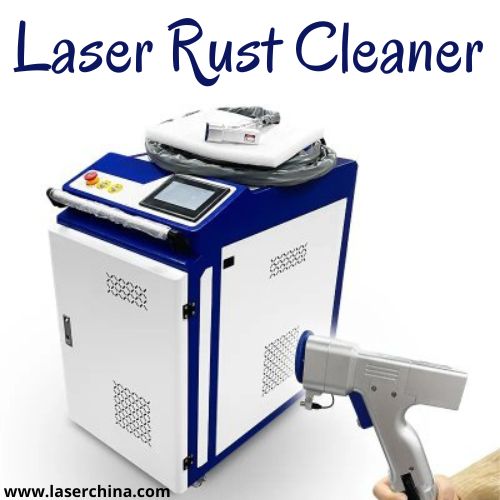
Rust has been one of the most persistent challenges in industries that rely on metal equipment, tools, and structures. Over time, exposure to moisture, oxygen, and varying environmental conditions causes corrosion that weakens the integrity of materials. Traditional rust removal methods such as sandblasting, chemical cleaning, or manual grinding have been widely used for decades, but they come with high labor costs, potential material damage, and environmental concerns. This is where the laser rust cleaner emerges as a transformative technology for industrial surface restoration.
A laser rust cleaner uses high-energy laser beams to target corroded surfaces with precision. Instead of relying on abrasive media or chemical reactions, it works through a process called laser ablation. The laser beam rapidly heats the rust layer, causing it to vaporize or detach from the base material without harming the underlying surface. This makes the technology an efficient, clean, and controlled solution for both small-scale and large-scale operations.
In this detailed guide, we will explore how a laser rust cleaner works, its major applications across industries, maintenance practices, operational considerations, and why it has become one of the most reliable tools in modern surface cleaning.
How a Laser Rust Cleaner Works
At the core of the system lies laser ablation. When the laser beam strikes the rust, the energy absorbed by the oxide layer creates a localized increase in temperature. Since rust has different thermal and optical properties compared to the underlying metal, the laser energy is absorbed more efficiently by the rust layer. This selective absorption allows the beam to strip away corrosion while leaving the base material intact.
The cleaning process involves three primary stages:
-
Absorption of Laser Energy – The rust absorbs the laser light more readily than the bare metal.
-
Rapid Heating and Expansion – The rust layer heats quickly, leading to micro-explosions that loosen the bond with the surface.
-
Evaporation and Removal – The loosened rust vaporizes or is blown away by compressed air, leaving a clean metal surface.
This process is non-contact, meaning the tool does not physically touch the material being cleaned. As a result, there is no abrasion, no wear on the base material, and no secondary waste such as sand or chemical residue.
Industrial Applications of a Laser Rust Cleaner
The versatility of a laser rust cleaner makes it suitable for a wide range of industries where corrosion control is critical. Below are some of the primary applications:
-
Automotive Industry
Car manufacturers and repair shops use laser rust cleaners to restore metal parts such as chassis components, exhaust systems, and engine housings. The non-invasive process ensures that precision components are not compromised during cleaning. -
Shipbuilding and Marine Industry
Ships and offshore structures constantly face rust due to exposure to seawater. Laser rust cleaners are used for surface preparation before painting or welding, ensuring that corroded layers are removed effectively without damaging the structural integrity. -
Manufacturing Plants
Heavy machinery, molds, and production tools often accumulate rust when left unused for long periods. Laser rust cleaners help maintain these machines by removing surface corrosion and extending operational life. -
Aerospace Industry
Aircraft components require precise cleaning methods to maintain safety and performance. Laser rust cleaners are used to restore parts without altering dimensions or introducing contaminants. -
Cultural Heritage and Restoration
Historical artifacts, statues, and structures often contain delicate surfaces that cannot withstand abrasive cleaning. A laser rust cleaner provides a safe and accurate way to restore such items without compromising authenticity.
Operational Considerations When Using a Laser Rust Cleaner
While laser rust cleaning technology is efficient, its operation requires a clear understanding of several important factors:
-
Power Settings
The efficiency of rust removal depends on selecting the right laser power level. Higher power can speed up the process but must be controlled to avoid heating the base material. -
Surface Type
Not all surfaces respond the same way to laser cleaning. Steel, iron, and aluminum show excellent results, while coated or layered surfaces may require calibration. -
Mobility and Accessibility
Portable laser rust cleaners are commonly used for on-site cleaning where large or immovable equipment needs servicing. Handheld models provide flexibility for irregular surfaces. -
Operator Safety
The use of high-energy lasers requires safety measures including protective eyewear, controlled work environments, and training to ensure safe handling.
Maintenance of a Laser Rust Cleaner
Like any industrial tool, proper maintenance ensures that a laser rust cleaner performs reliably over time. Regular care not only improves performance but also prevents unnecessary downtime.
-
Optics Cleaning
The lens and optical components should be cleaned regularly to prevent dust and debris from interfering with the beam. -
Cooling System Monitoring
Many laser systems rely on water or air cooling to maintain stable operation. Regular checks help avoid overheating. -
Software Calibration
Systems often include software for controlling beam intensity and focus. Routine calibration ensures consistent results. -
Component Inspection
Regular inspection of cables, connections, and power supplies prevents unexpected failures during operation.
Why the Laser Rust Cleaner Has Become a Preferred Tool
The demand for rust removal solutions that minimize labor costs, reduce waste, and preserve base materials has grown steadily across industries. A laser rust cleaner addresses these needs by offering controlled cleaning, reducing the need for consumables, and ensuring surfaces are restored without further damage.
Furthermore, its ability to work in both small-scale workshops and large-scale industrial environments makes it a versatile investment. Businesses that adopt this technology often find long-term improvements in efficiency, cost savings, and equipment life span.
Final Thoughts
Rust is more than just a cosmetic issue—it undermines the strength and reliability of metal components across industries. For decades, companies have relied on labor-intensive or chemical-based cleaning methods that come with significant trade-offs. The laser rust cleaner offers a modern alternative that combines precision, efficiency, and environmental responsibility. Its applications span from automotive repair to aerospace engineering, proving its adaptability in demanding environments.
As industries continue to look for innovative ways to improve productivity and protect valuable assets, the laser rust cleaner stands out as a solution that delivers consistent results with long-term benefits. By investing in this technology, businesses secure not only cleaner surfaces but also a stronger foundation for future operations.

